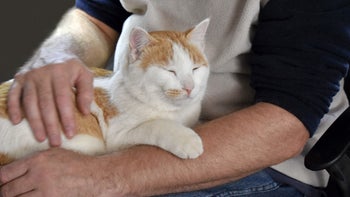
Ringworm in Cats: What It Looks Like and How You Treat It
Key takeaways:
Ringworm is a skin infection that can affect cats, humans, and other pets.
This type of skin irritation often looks like a ring on your cat.
Your vet can prescribe a ringworm medication that’s appropriate for your cat.
Access savings on related medications
Table of contents
Ringworm is a skin infection that can affect your cat and spread to other pets and humans. Contrary to its name, it’s not a worm at all: Ringworm is caused by a fungus. If you recognize the signs of ringworm early, you can get your cat appropriate treatment. Acting quickly can also prevent ringworm from spreading to others.
Though ringworm is very contagious, it’s usually easy to contain with basic cleaning protocols. Ringworm will often go away on its own. But it takes much longer without treatment. Here’s what you need to know about this common and completely treatable cat skin infection.
What is ringworm in cats?
Ringworm is a skin infection that can affect both pets and humans. It’s caused by a fungus that can sometimes lead to itchy, uncomfortable skin. Different types of fungi can cause ringworm. But about 98% of cat ringworm infections are caused by a fungus called Microsporum canis.
Save on the top 10 pet medications
Save big on common pet medications like Fluoxetine and Levetiracetam at your local pharmacy.

GoodRx is NOT insurance. GoodRx Health information and resources are reviewed by our editorial staff with medical and healthcare policy and pricing experience. See our editorial policy for more detail. We also provide access to services offered by GoodRx and our partners when we think these services might be useful to our visitors. We may receive compensation when a user decides to leverage these services, but making them available does not influence the medical content our editorial staff provides.
How do cats get ringworm?
Cats get ringworm when they come into contact with a fungus that causes the infection. That fungus can live on many surfaces, including blankets, grooming tools, and towels. It also ends up living on an infected human or animal’s skin and hair.
Examples of how ringworm gets transferred to cats include:
Sleeping next to or licking and grooming an infected pet
Being brushed with the same equipment used to groom an infected pet
Using the same bedding as an infected pet
Using the same furniture an infected pet has sat on — like in a shelter or boarding facility
If your cat comes into contact with ringworm-causing fungi, they won’t necessarily get an infection. Kittens and cats with compromised immune systems are more likely to develop ringworm than adult cats and cats with strong immune systems.
Also, long-haired cats tend to be sneaky carriers of ringworm. This is because, when they get infected, it’s not as noticeable compared to short-haired cats. Long-haired cats tend to shed more, too.
Symptoms of ringworm in cats
Ringworm infections can cause many symptoms, explains Jennifer Frione, DVM, a veterinarian and owner of Lakeside Animal Hospital in Florida. She told GoodRx Health that pet owners may see the following signs of the infection in their cat:
Circular areas of hair loss or broken hair
Redness
Scaling
Crusts
What does ringworm look like on a cat?
What ringworm looks like can vary by cat. The infection typically appears on a cat’s face, tail, ear tips, or feet. And it can look like:
Small, itchy, solid bumps
Large bumps with open sores
An irregular-shaped rash
Scaly, gray patches of skin
Read more like this
Explore these related articles, suggested for readers like you.
A cat’s claws can also become infected. Ringworm can cause a cat’s nails to:
Have a whitish color
Shred easily
Become deformed
Frione also said that some cats who have ringworm don’t show any symptoms.
How is ringworm in cats diagnosed?
If you think your cat has ringworm, it’s important to take them to the vet. Frione recommends that you keep your cat isolated until the appointment. When you put your cat into the carrier to go to the vet, wear gloves or wrap your cat in a towel.
Your vet can perform multiple tests to confirm your cat has ringworm. Frione said she often uses a skin culture and a PCR test. The PCR test helps identify the specific fungus that caused the ringworm infection.
Frione said that a vet might also use a Wood’s lamp to tell which hairs and areas are affected by ringworm. This handheld lamp uses ultraviolet light to examine your cat’s fur and skin. Affected hairs will glow under the light. Your vet might then take a swab sample from those areas.
Once your vet knows which fungus is causing your cat’s ringworm, they will recommend a treatment.
Ringworm treatment for cats
Ringworm is an uncomfortable infection, but treating cats with ringworm is fairly simple, as there are several different treatments and medications available. Your vet will recommend the best option for the specific fungus causing your cat’s ringworm.
Frione recommends using both topical and systemic antifungals to treat a ringworm infection. Topical medications are applied directly onto the areas of a cat’s skin affected by ringworm. A systemic antifungal is a medication that is given orally.
The most common oral medication prescribed for cats with ringworm is itraconazole. The most common topical treatment is a miconazole-chlorhexidine combination medication.
If your cat is prescribed a topical medication, do not allow them to lick the cream off as that can cause them to become sick. Keep your cat distracted and apply the medication during feeding time or when they’re playing. Give them treats to prevent them from grooming and licking off the medication.
Your vet may also prescribe an antifungal shampoo, cream, or dip. These treatments help disinfect a cat’s fur. Many cats with ringworm need a dip or bath using a prescribed antifungal shampoo twice a week.
Does ringworm go away on its own?
Ringworm can go away on its own, but it may take months. During that time, your cat could spread the infection to humans and other pets in your home. Not to mention, ringworm can be very uncomfortable for your cat. Giving your cat medication will help the infection resolve more quickly, relieving their symptoms.
Can you get ringworm from a cat?
If humans or other pets come into contact with the fungus, they can get ringworm, too. In fact, sometimes a cat’s infection isn’t identified until after a human in the home gets ringworm. If you get ringworm from your cat, it can take up to 14 days for you to get symptoms, like itchy skin. Most mild cases of ringworm resolve with treatment in 2 to 4 weeks.
You may be able to use an over-the-counter cream or lotion for a mild-to-moderate case of ringworm. Products that can be helpful to treat the infection include:
If the ringworm doesn’t improve, make an appointment with your healthcare provider. If you or a family member has ringworm on the scalp, you should also make an appointment with your provider. Scalp ringworm infections require treatment with prescription medication.
Keep in mind your cat can easily spread ringworm to other pets, including dogs, as well. Pets don’t always show symptoms of ringworm. So if your cat is diagnosed with ringworm, your vet may want to also examine and treat any other pets you have.
How to keep ringworm from spreading
Because ringworm can spread easily, it’s important to keep your infected cat away from other pets and humans. Frione recommends that you keep your cat in a small room that’s easy to clean until their infection has cleared. Try to avoid rooms with carpeting.
You’ll also want to take other steps to help prevent ringworm from spreading to you or other pets in the house. In general, it’s a good idea to:
Wear gloves while handling a cat who has ringworm.
Wash your hands with soap and water after you’ve handled a cat with ringworm.
Vacuum your home to remove fur and skin flakes, which could spread ringworm.
Remove cat hair from your furniture, bedding, and clothing.
Thoroughly disinfect surfaces where your cat sleeps or hangs out, including their pet carrier.
You can dilute 1/4 cup of chlorine bleach in 1 gal of water. This creates a disinfectant you can safely use on surfaces. Strong detergents are ideal for washing bedding, towels, and clothing items.
If you have a weak immune system, avoid handling your infected cat if possible. Frequent hand washing can also help to keep you from getting ringworm.
The bottom line
Ringworm is a common skin infection in cats that can easily spread to humans and pets. Your vet will help diagnose your cat and find the right treatment. Treatments typically include topical and oral medications and antifungal shampoos. While you’re treating a cat with ringworm, make sure to keep them isolated to avoid spreading the infection. Clean and wash areas where your cat spends time and wash your hands thoroughly after handling them.
Why trust our experts?



References
Austin Pets Alive! (2019). Woods lamp ringworm exam.
Brooks, W. (2023). Ringworm in dogs and cats. Veterinary Partner.
Centers for Disease Control and Prevention. (2014). Ringworm (dermatophytosis infection).
Centers for Disease Control and Prevention. (2020). Ringworm.
Centers for Disease Control and Prevention. (2021). Treatment and outcomes of dermatophytes.
Cornell Feline Health Center. (n.d.). Ringworm: A serious but readily treatable affliction.
Elanco US Inc. (2021). Itrafungol - itraconazole injection, solution [package insert]. DailyMed.
Jacobson, L. S., et al. (2018). Comparison of real-time PCR with fungal culture for the diagnosis of Microsporum canis dermatophytosis in shelter cats: A field study. Journal of Feline Medicine and Surgery.
Llera, R., et al. (n.d.). Ringworm in cats. VCA Animal Hospitals.
Merchant, S. R. (2018). Ringworm (dermatophytosis) in cats. Merck Veterinary Manual.
Moriello, K. A. (2020). Dermatophytosis in dogs and cats (ringworm). Merck Veterinary Manual.





























